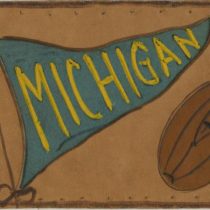Magazine

In Living Color
by Robert Havey
In 1867, a committee of students from the University of Michigan’s Literary Department was appointed to recommend colors emblematic of the school. Universities such as Harvard (crimson) and Yale (blue) had recently adopted official colors and, as the University Chronicle pointed out at the time, students wanted school colors so they “may be distinguished from other men, and particularly from students attending other institutions.” After a short deliberation, the committee unanimously chose “azure blue and maize.”
But not everyone had the same idea of what “azure blue and maize” meant. The committee gave no examples and no standards on the exact shade and hue. Variations appeared immediately, eventually resulting in multiple versions of the school banner on display in store windows throughout Ann Arbor.

A 1907 game-day postcard. BL009732
The most obvious contrast in colors was between the dark shades worn by university athletic clubs and the lighter colors used to adorn campus events. The sports teams preferred darker colors because, as the Michigan Alumnus put it in 1912, the paler versions of maize and blue were “inadequate and ineffective as decoration.”
This division continued until 1912, when the Regents formed a new committee to reconcile the disparate colors in time for U-M’s 75th anniversary.
The committee agreed with the athletic clubs that a darker blue—“lapis lazuli, Persian blue, cobalt blue, the clear blue color of the unclouded sky”—was more appropriate than the baby blue that had become the norm. Maize was simply defined as the color of corn, but the committee emphasized the pale lemon yellow “should be avoided.”
In hopes of ending color drift, the committee chose maize and blue ribbons to be the exemplars for all official University of Michigan colors from then on. The ribbons now reside in the Bentley Historical Library’s archive.
In 2015, the University launched a comprehensive branding campaign to ensure consistent use of logos and colors. The new standards are also archived at the Bentley—just in case they change again.
